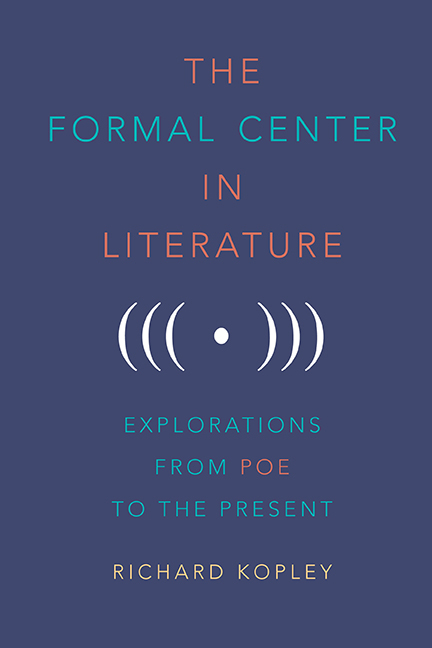Book contents
- Frontmatter
- Dedication
- Contents
- Acknowledgments
- Introduction
- 1 “Mournful and Never-Ending Remembrance” in Edgar Allan Poe's The Narrative of Arthur Gordon Pym
- 2 Retracing Our Steps in Edgar Allan Poe's “The Man of the Crowd”
- 3 “Scrutinizing the Parchment More Closely”: The Form of “The Gold-Bug” and Its Relationship to That of the Dupin Tales
- 4 Form and Reform in Nathaniel Hawthorne's “Earth's Holocaust”
- 5 The Circle and Its Center in Herman Melville's “Bartleby, the Scrivener”
- 6 Chiasmus in Henry David Thoreau's Walden
- 7 The Mythological Centers of Lewis Carroll's Alice Books
- 8 Table as Text in James Joyce's “The Dead”
- 9 The Structure of Sherwood Anderson's “Hands”
- 10 The Architecture of Ernest Hemingway's “The Three-Day Blow”
- 11 Balance in Dashiell Hammett's The Maltese Falcon
- 12 Framing Caesar in Raymond Chandler's The Big Sleep
- 13 The Ridge of the Domino in Patricia Highsmith's Strangers on a Train
- 14 The “X in the Air” in Joyce Carol Oates's “Where Are You Going, Where Have You Been?”
- 15 The Hybrid Center of Zadie Smith's White Teeth
- Notes
- Bibliography
- Index
14 - The “X in the Air” in Joyce Carol Oates's “Where Are You Going, Where Have You Been?”
Published online by Cambridge University Press: 14 June 2019
- Frontmatter
- Dedication
- Contents
- Acknowledgments
- Introduction
- 1 “Mournful and Never-Ending Remembrance” in Edgar Allan Poe's The Narrative of Arthur Gordon Pym
- 2 Retracing Our Steps in Edgar Allan Poe's “The Man of the Crowd”
- 3 “Scrutinizing the Parchment More Closely”: The Form of “The Gold-Bug” and Its Relationship to That of the Dupin Tales
- 4 Form and Reform in Nathaniel Hawthorne's “Earth's Holocaust”
- 5 The Circle and Its Center in Herman Melville's “Bartleby, the Scrivener”
- 6 Chiasmus in Henry David Thoreau's Walden
- 7 The Mythological Centers of Lewis Carroll's Alice Books
- 8 Table as Text in James Joyce's “The Dead”
- 9 The Structure of Sherwood Anderson's “Hands”
- 10 The Architecture of Ernest Hemingway's “The Three-Day Blow”
- 11 Balance in Dashiell Hammett's The Maltese Falcon
- 12 Framing Caesar in Raymond Chandler's The Big Sleep
- 13 The Ridge of the Domino in Patricia Highsmith's Strangers on a Train
- 14 The “X in the Air” in Joyce Carol Oates's “Where Are You Going, Where Have You Been?”
- 15 The Hybrid Center of Zadie Smith's White Teeth
- Notes
- Bibliography
- Index
Summary
COMMENTING ON her early stories, Joyce Carol Oates writes that “A number of these stories were constructed to move toward, and to illuminate, what I've called ‘moments of grace’—dramatic turns of action, as at the end of ‘Where Are You Going …’ when the presumably doomed Connie makes a decision to accept her fate with dignity, and to spare her family's involvement in this fate.” Accordingly, the construction of “Where Are You Going” deserves our particular attention. Richard E. Mezo has suggested that “the story's structure” involves “a clear dividing line”: the first portion, which culminates with Connie's sitting in the sun “‘dreaming and dazed’” and then shaking her head “‘as if to get awake,’” is realistic; the second portion, which involves the intrusion into Connie's life of Arnold Friend and Ellie Oscar, is a fantastic dream. I agree with Mezo that there is a “clear dividing line,” but I believe that it is located later in the work. I would argue that the two halves of the story are distinguished not so much by realism and fantasy as by a slightly ragged reversal of language from the first half in the second half. The moment of crossing over, I would contend, is Arnold Friend's drawing an “X in the air.”
“Where Are You Going, Where Have You Been?” is Oates's muchanthologized 1966 story about Connie, an adolescent girl in a torpor of nascent sensuality, who is both entranced and threatened by Arnold Friend, a man disguised as a teenager. Accompanied by his sidekick Ellie Oscar, Arnold Friend has driven to Connie's otherwise-empty house one Sunday afternoon to take her away—probably to rape her, possibly to kill her. Initially resisting, she eventually goes with him to save her family from his promised violence—her willingness to sacrifice herself triumphs over her narcissism. The story was suggested by a Life magazine article titled “The Pied Piper of Tucson,” about twentythree- year-old Charles Schmid, who murdered three teenaged girls. Several influences, as Oates has noted, included a medieval engraving of “Death and the Maiden,” Bob Dylan's song “It's All Over Now, Baby Blue,” and various fairy tales. Oates's terrifying and surprising tale is enabled and deepened by its subtly elaborated form.
- Type
- Chapter
- Information
- The Formal Center in LiteratureExplorations from Poe to the Present, pp. 116 - 121Publisher: Boydell & BrewerPrint publication year: 2018



